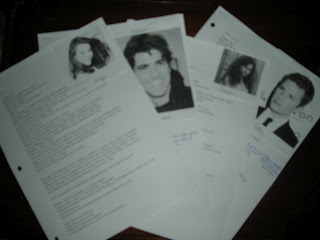Manuscript Makeover Part 1: Character
Last summer, a writer's group invited me to teach a class on editing from start to finish. I designed my manuscript makeover class for them, and I've decided to share it on my blog as a series of posts.
Today I'll discuss editing for character, which is one of the most important parts of writing a novel. This involves making sure your reader will like your main characters and also making sure they understand your characters' emotions and thought processes.
First, it's important that readers love your main character(s).
As Blake Snyder says, "Liking the
person we go on a journey with is the single most important element in drawing
us into your story.”
Here are ten ways to make
a character more endearing:
1. Have your
character do something heroic in the opening scene. (Think of Mr. Incredible in the opening scene of The Incredibles.)
2. Make them
funny. (Phil from Groundhog Day is good example of how this can work well.
3. Make them a
good friend to another character. (Think of Cher from Clueless or Sam from Lord of the Rings.)
4. Give them
special talents or abilities. (This is why we like Shelock Holmes.)
5. Make them
attractive. (Basically any female main character in a movie.)
6. Make us feel
sorry for them. (Harry Potter is a good example of this.)
7. Make the bad
guy worse. (Think of Luke Skywalker and Darth Vader.)
9. Give them
something we wish we had. (Captain Kirk from Star Trek can travel anywhere he wants, so people like him despite his negative qualities.)
9. Make them
proactive. (This is why women love Elizabeth Bennet from Pride and Prejudice.)
10. Don’t let
them get too negative about themselves or other characters.
Second, ask yourself whether your reader can relate to your characters:
Can the reader
feel what the character feels?
Can the reader
understand why she says what she says and does what she does
You can do this through dialogue tags. I like to write down examples of great dialogue tags that I encounter while reading. Here are some examples from
JoJo Moyes' Me Before You. Notice how they reveal her characters' emotions and thoughts:
Describing
voice:
“Her voice is
husky, testament to their missed hours of sleep.”
“He said it like
it was a question.”
“When Patrick
spoke again, there was a faint air of martyrdom in his tone.”
Describing
internal feelings:
“How could I
explain to him . . . how a body can become so familiar to you?”
“I couldn’t stop
beaming.”
“I turned to
face Mrs. Traynor, wriggling so that my jacket covered as much of the skirt as
possible.”
Main character
interpretting others’ dialogue and cues
“She withdrew
her hand from mine as soon as humanly possible.”
“Only later I realized
he hadn’t seemed happy when he said it.”
“Mum shut her
eyes for a moment, as if calming herself before she spoke.”
Another way you can help readers identify a character's emotions or thoughts is through descriptions. Make sure that when you describe a setting, a character, or an action, you do it from your character's point of view and not your own. I've been reading the Little House books by Laura Ingalls Wilder, and I'm so impressed with how well she tells her stories from a child's point of view. I invite you to read a few chapters from any of her books to see what I mean.
A good way to know if you're on the right track is to ask critique groups
and beta readers if they can relate to your characters.

Comments
Post a Comment